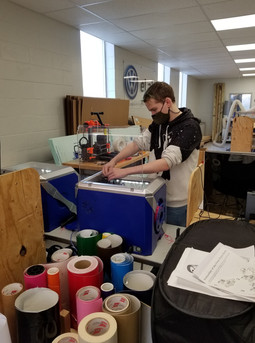CCA students learning to create voice-operated prosthetic arm in VW eLab
- PEF Innovation Hub
- Dec 21, 2020
- 2 min read
Updated: Apr 6, 2021
Volkswagen eLab students at Chattanooga Center for Creative Arts (CCA) have been learning to apply real-world problem solving, while designing voice-operated prosthetic arms. This project, made possible thanks to a grant from Tennessee Valley Authority (TVA) and Battelle earlier this year, helped provide 3D printers and over 40 tech kits for each student.

Students in Jamie McCurry's class created their own iteration guide as the starting point for the project and collaborated in groups to give feedback to each other’s ideas. "I've enjoyed this class and the fact that we all get to collaborate to create something that will have a positive impact on someone's life," shared one of McCurry's students. "Also, listening to different perspectives from classmates has helped improve our learning and design process."

The design process involved following the Design Thinking Framework above. Students took initiative to decide what parts or materials were required, as well as determining scaling of a left or right arm. For most, this was their first time learning how to build a prosthetic arm, including learning how to use the VW eLab tools to create it. Some students shared learning challenges in the beginning, including being unfamiliar with robotics or coding and creating a fully functional arm without any prior experience or knowledge in that area. Elaborate research played a pivotal role in learning how to incorporate parts together to build their own prototype, and exploded views helps show how all pieces fit and how many of each part need to be printed.
Drawings above by student, Hope Daan.
The first step of the design thinking process, Empathize, posed the question: Who is the design for? Specifically for this project, the design involves restoring basic capabilities to someone who lost a limb or lost functionality in that limb. Students brainstormed ways the arm could serve multiple functions and be enjoyable to wear, some of which included making the prosthetic lightweight, easily moveable, and helpful with day-to-day activities such as eating and walking. Student, Emma F., shared that they sought out comfortable material and a way to activate voice functionality, as well as hard work and motivation. “Success, to me, is coming up with a design that functions well and a design that the person wants to show off. They should not have to feel insecure.”

Prior to the holiday break, students were at the prototyping stage, 3D printing many of the parts. Once all the 3D parts are completed, students will move to the next stage - incorporating the audio portion. Student Timmy W. has already begun researching the voice-operated portion. "Coding is going to take a while because of all the new components we'll have to integrate, including the voice activation, but we're excited to learn how to do that."
Thanks to CCA students for sharing their learning journey with us, while helping others uncover real world solutions! With many talented artists and designers in McCurry's class, we look forward to see the final voice-operated prosthetic in use and transform someone's daily life.
*Photos contributed by CCA's VW eLab specialist, Jamie McCurry.

































Comments